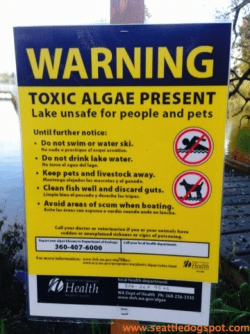Current Conditions a “Perfect Storm” for Toxic Algae
KREM News reported last week that an official from the Washington State Department of Health warned that “extreme heat this summer and lower than normal water levels as causing a perfect storm for algae blooms across Washington.”
“Due to ongoing drought and warm temperatures in our state, lakes, rivers, and streams are under tremendous stress right now,” said Acting Washington State Department of Health Chief Science Officer Scott Lindquist, MD, “As a result, we are receiving reports of toxic algae blooms in areas we have not seen before.”

Currently, 10 waterways in Washington are closed to dogs and humans due to dangerously high levels of toxic algae.
Toxic Algae May Have Killed 3 Spokane Area Dogs
Toxic algae blooms could have caused the deaths of 3 dogs that swam in the Little Spokane River earlier this month according to the Washington State Department of Ecology.
The Washington State Department of Ecology found blue-green algae in samples taken from the Little Spokane River after the deaths of the three dogs.
A Department of Ecology spokesperson said the presence of blue-green algae does not give a clear answer about whether it was the cause of the dogs’ deaths but it doesn’t rule it out.
Colton Bridges told KREM news that the dogs “became severely sick and died” about 20 minutes after he brought the dogs to dry off.
“Christa took the son to bed and took the dogs inside to dry off for the night,” Bridges told KREM. “20 minutes later she goes into check on the dogs and all three of them are just laying right next to each other dead.”
The agency and Spokane Regional Health District are currently investigating other Spokane area water sources for toxic algae blooms.
Most dog owners haven’t heard of toxic algae blooms. I certainly hadn’t until I starting this website. But toxic algae is a huge threat to dogs during hot weather.
Warmer Weather, Increased Activity Cause Toxic Algae Blooms
Blue-green algae is present in Washington waterways throughout the year. It becomes toxic when warm weather and more activity in the lake stir up phosphorus sediments from the bottom of the lake and other nutrients that the algae feed on.
Toxic algae blooms don’t usually form in moving water, but the dry summer has reduced river flow in the state, according to the news release. This has created spots in rivers and streams that can be ideal for bloom formation.
Blue-green algae can produce two types of toxins are more common in Washington waters: microcystins and anatoxin-a.
Symptoms of Toxic Algae Poisoning in Dogs
Microcystins are a group of toxins that affect the liver. Because microcystins are the most commonly-found cyanobacterial toxins in water, they are the toxins most responsible for human and animal poisonings.
Dogs that ingest microcystins will show one or more of these symptoms:
- Weakness
- Lethargy
- Lack of appetite
- Vomiting
- Diarrhea (dark, tarry stool)
- Bleeding
- Pale gums
- Jaundice (yellow tint to gums and skin)
- Shock
- Seizures
- Collapse and coma
- Death
Anatoxin-a is a potent toxin that affects the nervous system. Symptoms include lethargy, muscle aches, confusion, memory impairment, and, at sufficiently high concentrations, death.
Dogs that ingest anatoxin-a will show one or more of these symptoms:
- Weakness or inability to walk
- Excessive salivation
- Excessive tearing
- Difficulty breathing
- Blue discoloration of skin and mucous membranes
- Tremors
- Seizures
- Muscle rigidity
- Paralysis
- Disorientation
- Coma
- Death
Dogs Are Particularly Susceptible to Toxic Algae Poisoning
A dog exposed to toxic algae can have respiratory paralysis which can kill it within 30 minutes from the start of these symptoms.
KREM reported that pet experts from Washington State University’s College of Veterinary Medicine say 60% of dogs who diagnosed with blue-green algae poisoning died from it.
Blue-green algae usually looks like blobs of floating scum or greenish streaks of oil-like substance in the water.
Dogs are particularly susceptible to toxic algae because they often drink the water they swim in and lick their fur after swimming.
“One of the things that’s important is if your dog gets into water that looks funny to you, some dogs are exposed by licking themselves. So if you see if they’re a funny color or have something on them, you will want to brush them off as fast as you can so they won’t groom the material off of them,” Dr. Beth Davidow from the Washington State University’s College of Veterinary Medicine told KREM.
You can monitor which Washington waterways have dangerous levels of toxic algae at the Department of Ecology’s Freshwater Algae Site. To look up specific waterways, check out the site’s database.
10 Washington Waterways Currently Closed Due to Dangerous Levels of Toxic Algae

Currently, these Washington lakes have high levels of toxic algae:
Anderson Lake – Jefferson County
Hicklin Lake – King County
Lacamas Lake – Clark County
Round Lake – Clark County
Lone Lake – Island County
Spanaway Lake – Pierce County
Palmer Lake – Pierce County
Roland Lakle – Klickitat County
Scootney Reservoir – Franklin County
Lake Lawrence – Thurston County
Your local jurisdiction may have more specific information about your lake. If you have questions contact Lizbeth Seebacher at Department of Ecology.
If a lake is not listed, it has not been tested for toxic algae through the Department of Ecology program.
Finally, remember that the Department of Ecology tests water quality in waterways on a rotating basis. This means that waterways within state recreation guidelines could develop hazardous levels of toxic algae before the state tests it again. That’s why it’s important to check for toxic algae blooms in any water before your dog dives in.








Leave a Reply